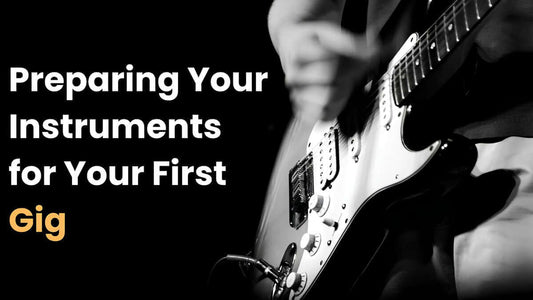Nothing kills the energy of a live performance faster than an ear-piercing feedback loop. Whether you're a guitarist, vocalist, or part of a full band, dealing with feedback can be a nightmare. Fortunately, with the right techniques, you can significantly reduce the risk of feedback and keep your performance smooth. In this guide, we'll break down everything you need to know to avoid feedback problems during live shows.
Understanding Feedback
Before tackling solutions, it's essential to understand what feedback is. Audio feedback occurs when sound from a speaker is picked up by a microphone and re-amplified in a loop. This results in the loud squealing or humming noise that we all dread.
Several factors contribute to feedback, including:
- Microphone placement
- Monitor positioning
- Gain and EQ settings
- Room acoustics
- Type of equipment used
By addressing these factors, you can minimize or eliminate feedback entirely.
Tips to Avoid Feedback During Live Performances
1. Position Your Microphones Correctly
One of the primary causes of feedback is poor microphone placement. Here are some placement tips:
- Keep microphones pointed away from speakers and monitors.
- Use directional (cardioid) microphones that reject sound from the rear.
- Maintain a proper distance between the microphone and the sound source (like your mouth or instrument).
- Avoid excessive movement with handheld microphones.
2. Optimize Monitor and Speaker Placement
Monitor and speaker positioning is crucial in preventing feedback. Consider these points:
- Position monitors to the side of vocal microphones rather than directly in front.
- Angle monitors correctly so they don’t project directly into the mic pickup pattern.
- Use in-ear monitors (IEMs) instead of floor wedges to eliminate monitor-related feedback.
3. Control Your Gain Staging
Setting proper gain levels prevents excessive signal amplification, reducing the risk of feedback:
- Set gain levels properly on each input channel. Start low and increase gradually.
- Use the gain before feedback (GBF) rule, which ensures that your mic levels are optimized without exceeding the feedback threshold.
- If using multiple mics, avoid overlapping frequency responses that might amplify the same sounds.
4. Use EQ to Cut Problematic Frequencies
Feedback often occurs due to specific frequencies resonating in a loop. Use EQ techniques to fix this:
- Identify feedback-prone frequencies using a graphic equalizer or parametric EQ.
- Cut (reduce) the most problematic frequencies instead of boosting others.
- A notch filter can be used to target and reduce narrow problematic frequency bands.
- Avoid excessive high or low-frequency boosts that can induce feedback.
5. Invest in a Good Feedback Suppressor
If feedback issues persist, using a feedback suppressor or digital sound processor (DSP) can help. Some advanced mixers come with built-in feedback suppression technology. These tools analyze sound and automatically eliminate frequencies that cause feedback.
6. Use Noise Gates and Compressors
Noise gates help by muting unwanted sound when a performer isn’t actively singing or playing. Similarly, a properly set compressor can control dynamic range, preventing excessive mic gain that may cause feedback.
7. Choose the Right Microphone for the Job
Not all microphones are created equal. Choosing the right type can make a big difference:
- Cardioid microphones: Reject sound from the sides and rear, making them ideal for live performance.
- Supercardioid or hypercardioid microphones: Provide even more rejection, but require careful monitor placement.
- Dynamic microphones: Less sensitive to background noise, making them less prone to feedback than condensers.
8. Adjust Stage Volume and Sound Balance
Excessive stage volume is a major contributor to feedback. Follow these best practices:
- Keep stage volume levels manageable—don't crank up monitors unnecessarily.
- Work with your sound engineer to create a good front-of-house mix without over-relying on stage monitors.
- Encourage band members to use IEMs to maintain clarity without needing excessive monitor levels.
9. Manage Room Acoustics
The acoustics of the venue play a huge role in sound behavior. If you’re performing in an echoey hall or a venue with reflective surfaces, you may need to adjust your approach:
- Use acoustic treatments like foam panels or curtains if possible.
- Position equipment strategically to minimize reflections.
- Work with your sound tech to make necessary EQ adjustments for the room.
10. Soundcheck Properly Before Every Show
A thorough soundcheck helps identify potential feedback issues before your performance:
- Walk around the stage and test microphones at different positions.
- Adjust monitor levels and EQ settings as needed.
- Simulate real performance conditions (sing/play at full intensity) to anticipate possible issues.
Valuable Resources
Here are some resources to help you improve your sound setup and eliminate feedback:
FAQs
Q: Why does feedback happen more in smaller venues?
Answer: Smaller venues often have less space to properly position speakers and monitors. This increases the chances of sound waves reflecting into microphones, leading to feedback.
Q: Can wireless microphones help prevent feedback?
Answer: Not necessarily. Wireless mics prevent cable clutter but don’t inherently reduce feedback. Proper mic choice, positioning, and EQ adjustments are more critical.
Q: What’s the quickest way to stop feedback mid-performance?
Answer: Reduce the monitor volume, step slightly away from the mic, and use the EQ to cut the offending frequency. If available, engage a feedback suppression system.
Q: Does feedback damage speakers or microphones?
Answer: Yes, prolonged exposure to high-frequency feedback can damage speakers and even mics. It’s best to resolve it quickly to avoid wear and tear.
Q: Should I always use a feedback suppressor?
Answer: Only if feedback is a recurring problem. Proper sound setup and EQ should handle most issues, but a suppressor is useful for unpredictable situations.
Conclusion
Feedback can be a serious issue during live performances, but with the right techniques, it can be minimized or eliminated. Proper mic and monitor placement, gain control, EQ adjustments, and the use of quality gear all play essential roles. By following these steps, you'll ensure a smoother, more professional performance every time.
Got questions? Let us know in the comments, and happy gigging!





